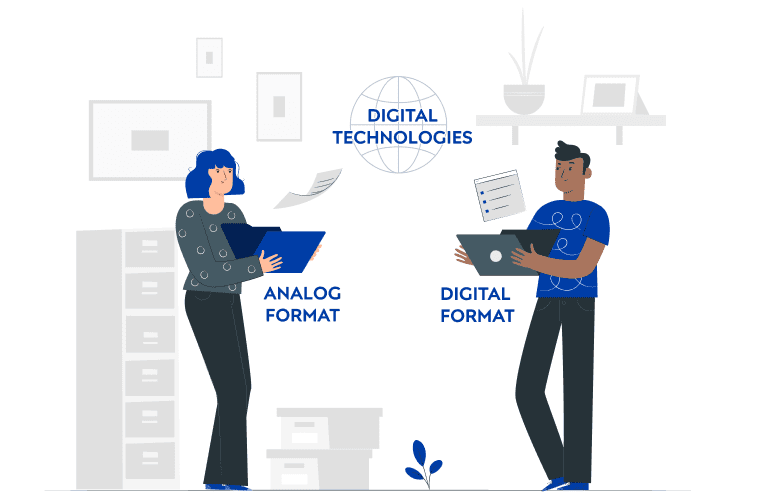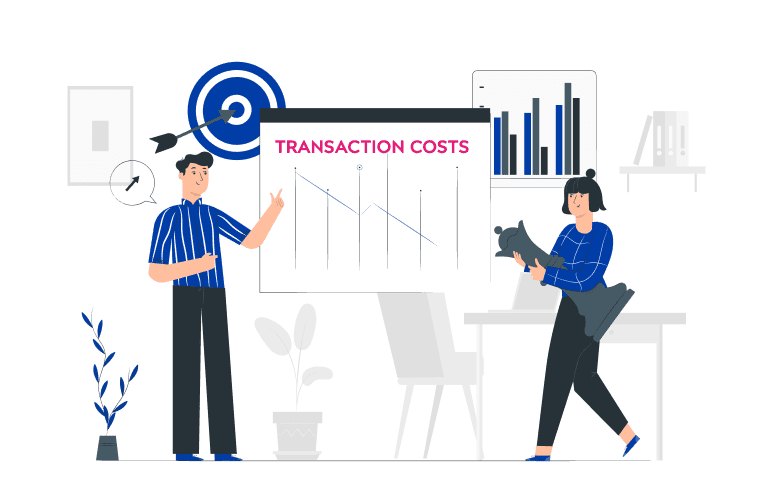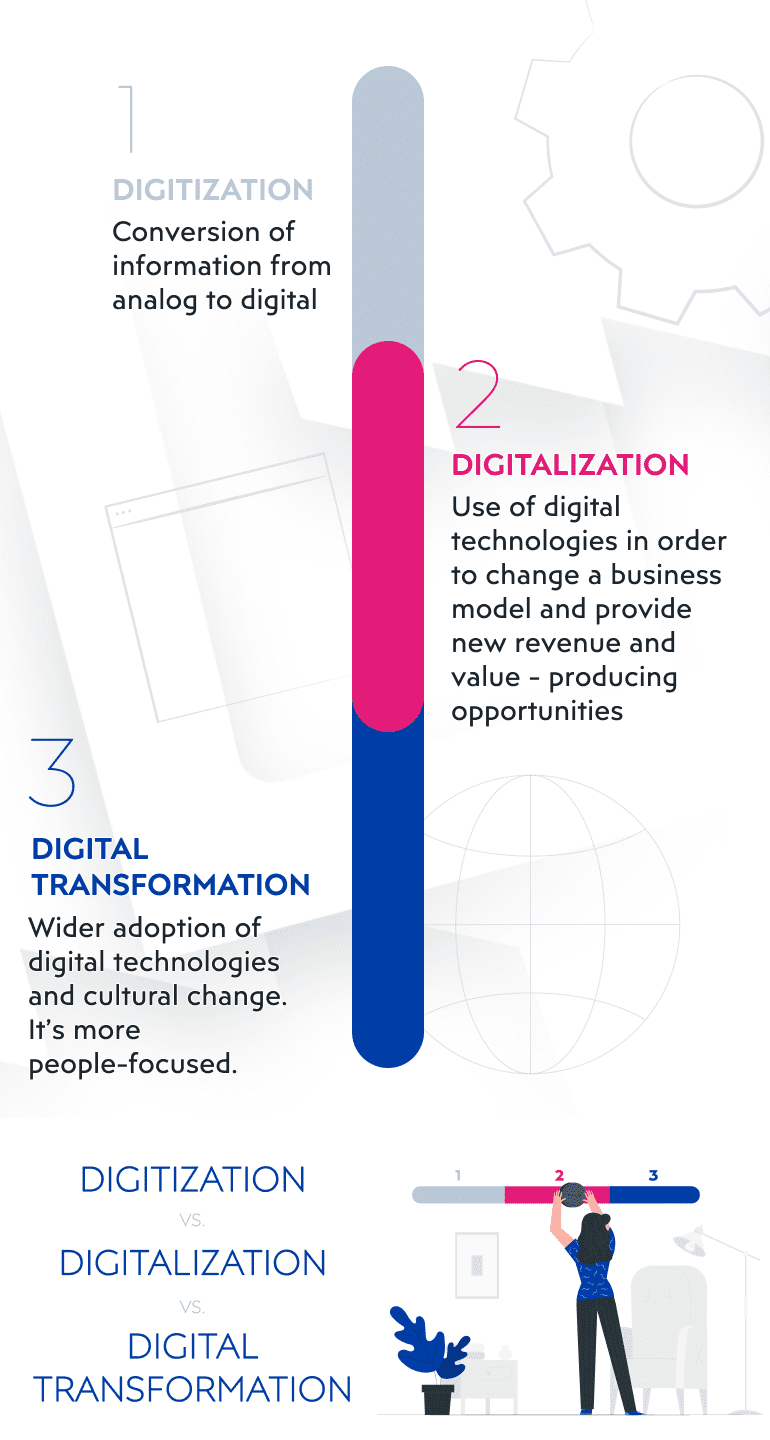Digitalization in many cases proves to be a prerequisite for success nowadays. Digital technologies are something that every business needs to take advantage of.
Digitalization happens when a business starts using digital technology in order to change its business model and create new revenue streams and new value-producing opportunities.
Nevertheless, many still don’t know what digitalization actually means. It gets often confused with digitization and digital transformation and we’re here to make this topic clear.
So, let’s dive into the article and clarify the whole topic of digitalization.
What Does Digitalization Mean and What Does It Stand For?
Great question! And definitely one of the most important.
Gartner states that digitalization refers to the use of digital technologies in order to change a business model and create new revenue streams and value-producing opportunities.
Today, it’s present in all of our activities and processes which involve digital technologies.

Many companies saw this as a great opportunity and have successfully leveraged digital technologies in order to optimize their business, from processing their orders to automating their marketing activities.
But to fully understand the extent of digitalization, we must understand the technology behind it.
You’re already familiar with a large portion of technology used in the digitalization process, so this will come easy to you.
For instance, data storage isn’t the same as it used to be. Companies nowadays are turning to cloud storage, as it serves them as a much safer option.
Cloud computing has led many companies to the point where they have an extraordinary competitive advantage. Even I use cloud databases on a daily basis! They have proven to have a positive impact on my productivity and performance – as they have for other colleagues and companies.
So, let’s discuss some of the changes the digitalization has brought to all of the businesses.
Digitalization Impacts Customer Behavior
Customer behavior is ever-changing and businesses need to adapt accordingly.
Digitalization has sparked the extreme change in customer behavior, as customers today are setting new expectations on a daily basis.
Just remember how the shopping process looked 10 years ago. It looked much different than it does today.
To additionally support that statement, GE Capital Retail Bank’s study has found that 81% of customers conduct online research before they even head out to the store. Not to mention that many of them choose to buy online, instead of going to a physical store.
Digital technology has found its way into customers’ homes and they have quickly adapted do it. Now, they are constantly searching for alternatives on their mobile devices. They’re consuming all of the information presented to them on web and mobile apps.
Worthy of pointing out is that they aren’t comparing your products and services only to those of your competitors. They are comparing them to the offerings of other industries.
Today, businesses are usually built customer-centric. In the last 10 years, we’ve witnessed a huge boom that led businesses from product-centric to the customer-centric way.
If your business can solve your customers’ problems, what if some other business in an industry different than yours can solve that problem too and provide more value?
This is the point where you, the business owner, stand out and, together with your team, lead your business with a new strategy.
Customers are continuously pushing companies to reach higher levels, as they are influenced by the global market and experiences provided to them by major brands.

Effects of Digitalization on Knowledge Management
Digitalization has brought the knowledge-gathering process to a higher level. Every company should be aware of that and leverage this fact to their advantage.
You should learn how to create additional value by bringing together both IT and non-IT departments and forming collaborative groups. This will not only create additional value but the inclusion of IT departments in your decision-making process will play a much bigger role.
Together, you’ll have the chance to change the way your business creates value and overcome the challenges you’re facing.
Furthermore, establishing relationships with external communities is of great importance, as it is to further your relationship with your own company. Learn how to capture value when owning and managing elements of your internal processes.
To sum it up, digitalization made collaboration of a large variety of people possible. IT and non-IT departments are coming together and they are impacting the way businesses create additional value.
Now, this may seem to already hint at the term of digital transformation, but we’ll discuss it later in the article.
Lower Transaction Costs as a Result of Digitalization
This is one of the greatest benefits of digitalization, as it directly impacts your expenditure.
Nowadays, businesses such as yours are in a position to test new goals and technologies in a low-risk environment. By doing that, you can easily decide if a certain strategy is going to be cost-effective or not.
How does it work?
Advertising is an industry that’s heavily impacted by digitalization. Advertising on digital platforms has proven to be more effective and efficient than any other channel.
Let’s take Facebook Ads as an example.
When you create an ad campaign, you then create ad sets, and finally – you create the ad.
There is a ton of inputs that are fully in your control, meaning you can test alternatives and decide on a new strategy.
For instance, if you’re targeting the USA in your ad campaign, but the data you gathered tells you that Canada may also be a lucrative market. You can tweak your ad set and select Canada as your target audience.
That way, you’ll have two parallel ads, one targeting the USA and one targeting Canada. You can test each ad with a certain fixed budget (which is usually very small) in order to use your budget as efficiently as possible.
Let’s say that after one week, the ad that targeted Canada performed 65% better than the USA-focused one.
From this kind of results, it’s easier to develop new strategies and tweak your advertising.
This is just one example of how digitalization improves your efficiency and performance.
Startups hold a special place in the business world, as their foundations are built upon continuous testing and adapting.
“In the new world, it’s not the big fish which eats the small fish, it’s the fast fish that eats the slow fish.”
Klaus Schwab, Founder and Executive Chairman of the World Economic Forum
Klaus Schwab tends to explain how the business world functions in the age of digitalization – in just one sentence.

And now when we’ve discussed more on what digitalization stands for, let’s see if there are some more benefits for you and your business to uncover!
Benefits of Digitalization Your Business Can Experience Even Today
As we already said, a lot of changes were brought to the table thanks to the digitalization.
We’ll go through some of them and discuss what opportunities are waiting for your business.
So, some benefits include:
- Increased efficiency
- Fewer human-made errors
- Safer data storage (cloud solution)
- Thorough data analysis
- Reduced costs
Let’s clarify these benefits for a bit.
All of these benefits are connected to each other which shows that digitalization doesn’t impact just one or two segments of your business. It’s safe to say that it changes the way the whole business operates.
After implementing digital technologies in your business, workflows are now streamlined and there aren’t so many human-made errors. Thanks to these streamlined processes and workflows, all of your internal and external operations are executed much more efficiently. This increased efficiency leads to the reduction of operational costs company-wide.
Storing your data on the cloud is also one of the biggest perks of digitalization. All of the information becomes easily accessible to all of your employees and there are no unwanted data silos.
Cloud storage has become a standard nowadays and sometimes it’s hard to even imagine a company not using cloud storage. By using cloud storage, you’ll be setting yourselves on for careless digital asset management. And that’s great!
Data analysis also improves significantly with the implementation of digital technologies. For instance, many companies would feel lost without using tools such as Google Analytics. It has become a foundation for data analysis, as a tool such as this one provides detailed information about your visitors and customers.
But let’s see what else digitalization brings to the table.
Digitalization Improves Digital Presence
The increase of digital presence is one of the most visible (and most important) benefits of digitalization.
A company that’s present on social media, various websites, and business directories has its visibility multiplied.
Today, having an online presence is a must. A huge focus has been placed on digital channels and you too should focus on them.
Leveraging the digital presence leads to the evolution of communication, so let’s clarify it a bit.
The Impact of Digitalization on Communication Channels
Not only did the digitalization increase the company’s digital presence, but it helped create new communication channels.
Social media, emails, and mobile and web applications are just examples of these newly-emerged communication channels.

The use of those channels may significantly increase both your sales revenue and your customers’ loyalty. But there is always a “catch”. It needs to be done effectively. Every new communication channel you obtain requires more responsibility.
By harnessing the power of digital communication channels correctly, you even have the chance of implementing an omnichannel strategy!
You need to adjust your communication to each channel and successfully communicate with your target audience. But I won’t talk about this anymore, as you’re more than familiar with social media communications.
Digitization vs. Digitalization vs. Digital Transformation
These 3 terms may sound similar, but they greatly differ. When you consider them equal, you’ll quickly find yourself in an unwanted situation.
Let’s see how they differ (and show some examples).
Digitalization vs. Digitization
Digitalization and digitization are surely connected, yet they still differ. Digitization precedes digitalization, meaning that digitalization isn’t possible without digitization.
Digitization refers to the conversion of information from analog to digital formats. And as I previously mentioned, digitalization refers to the use of digital technologies in order to create new value-producing opportunities and change the way you interact with your customers.
Digitization is more mainly-focused on optimizing internal processes, such as work automation and minimizing paperwork.
Digitalization vs. Digital Transformation
Even though digitalization is often misunderstood for digital transformation, these 2 terms are significantly different.
Digital transformation refers to the much wider use of digital technologies, implementing it into all areas of your business. Digital transformation also refers to a cultural change, with an emphasis on changing the corporate culture.
It’s more people-focused, and as you can already see, a much broader term than digitalization.

Why Should You Differentiate Digitization, Digitalization, and Digital Transformation?
Many leaders have already found themselves in an unwanted situation, where they misunderstood these 3 terms.
If you’re not fully familiar with the differences between digitization, digitalization and digital transformation, you may be missing out on many opportunities to gain a competitive advantage and transform your business into a fully agile and digital one.
I’ll demonstrate the difference between these terms in a short example.
Let’s say you’re organizing a 6-month education for aspiring entrepreneurs who want to learn more about business in general. First, they need to come to your office and they’re required to sign in on a sheet of paper, proving their application. After they do that, you collect all of the paper sheets and upload them to your computer as PDF files.
This is an example of digitization. You have converted an analog data format (paper sheet) to a digital format (PDF file).
After your students have successfully applied, you inform them of an application you’ve prepared for them, where they can upload all of their assignments, mark their attendance on your online classes and even read your informative articles. To attend your 6-month education, all of the attendees must download the application to their devices.
You can easily communicate with all of the attendees via the application and give feedback on all of their assignments. Every document they upload is shared with you, or with all of the other attendees. To use your application and all of its attachments, they need to enter their email address.
This is an example of digital transformation. It has affected the whole process of education, not just a single process, such as converting a paper sheet to a PDF.
Some time has passed and one of your students decided that he’s going to quit the education and pursue another goal. Before they do that, they need to fill out a form on the application.
Upon completion, the form is sent to your HR department and automatically stored in the cloud. When your HR department approves your student’s leave request, both you and the student will get a notification on the app.
This is an example of digitalization. Digital technologies are widely used and there is no paperwork. Every bit of information stored in the cloud and all of the processes are digitalized.
Now when I’ve clarified the differences between these terms on a few examples, let’s see which industries adopted digital technologies and digitalized efficiently.
Successful Examples of Digitalization
There are many industries that have already adopted the use of digital technologies in their day-to-day operations and I’ll point out just a few of them.
When searching for examples of digitalization, Google probably won’t offer you with much information you’re seeking for, rather it will show you examples of digital transformation and digitization.
So, let’s check out how some major industries digitalized their processes!
Banking Industry
The banking industry is an exceptional example of the use of digital technologies.
First off, just take a quick look at your mobile phone.
You probably already have a mobile banking app. This just shows how the banking industry evolved over the years. And the best thing is – it functions the same way it does offline.
You can pay with your mobile app, pay your bills, transfer money to other accounts, and so on.
Online banking has become one of the most recognized industries when it comes to digitalization. There is no need for leaving your home just to put your money into your savings account!
Banks have ensured that their mobile apps are secure and reliable and that you can handle your money much easier than you could do it offline.
To further this thought, there are now banks emerging with no physical branches whatsoever. All of their operations are conducted online and they are leading the industry to create a new fully-automated banking system.
Advertising Industry
It may not seem as shocking news, but the advertising industry has been heavily impacted by digitalization.
For the sake of example, let’s take a look at Facebook Ads and Google Ads. They are two of the most used advertising platforms today.
Remember how advertising looked 10 or 15 years ago. It was significantly different than it is today.
Today, thanks to digital technologies and advertising platforms such as Google Ads and Facebook Ads, we can conduct thorough research on target audiences, products and services, competitors, and so on.
“Half the money I spend on advertising is wasted, the trouble is I don’t know which half”
John Wanamaker, merchant, political figure, a pioneer in marketing
Tell me, would you agree with John Wanamaker?
For those who aren’t familiar with John Wanamaker, he’s an American 19th-century merchant and a political figure. Just imagine how much has the advertising changed since he said this.
There are many reasons why it’s logical to disagree with him today. Just a reminder – we’re in the age of digitalization where we can measure absolutely everything.
Google Analytics is one of the most powerful analytics tools available today. Many of you are already familiar with it and probably have used it in the last few days. As you already know, you can use it to track everything – every action users take on their devices.
After analyzing your current audience, you can advertise your products and services without the trouble of wasting your money, as John Wanamaker says.
Digitalizing your business isn’t just an option today, it’s a necessity. Even for a brick and mortar business. If you aren’t evolving your business along with the technology, you’re fighting an uphill battle.
And if you’re a retailer, implementing digital technologies may some doors for you and enable your business to become an omnichannel one!
What’s Your Next Move Now?
After you’ve realized the importance of digital technologies for your business, it’s time to do something about it.
If you want to digitalize your business, look no further. I’d like to help you with any questions you may have so don’t hesitate to shoot me up.
Also, it would be great if you’d comment your questions and impressions down below so all of the readers could benefit from it!
I hope this article was useful and that it clarified some issues you may have already had.
Until next time.
going digital concept -DepositPhotos


